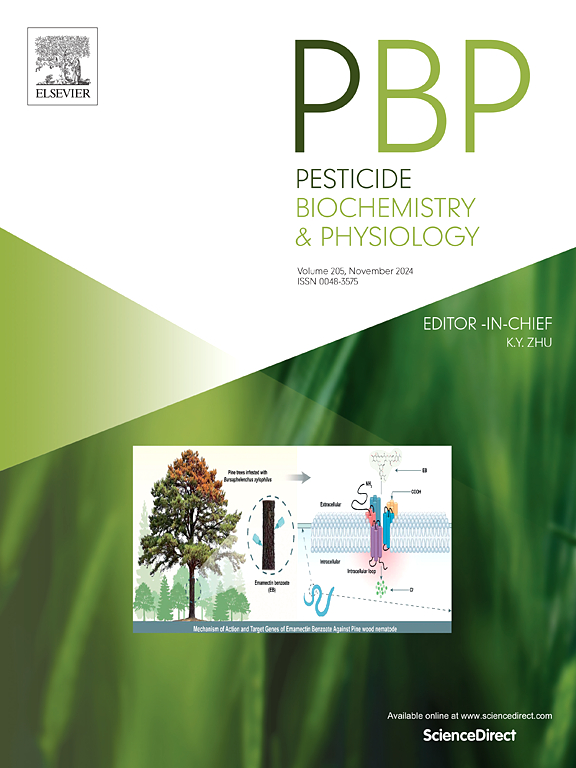整合转录组和基于 1H NMR 的代谢组,探究鞘翅目昆虫对氟嘧啶的潜在响应机制
IF 4.2
1区 农林科学
Q2 BIOCHEMISTRY & MOLECULAR BIOLOGY
引用次数: 0
摘要
氟嘧啶(FLP)是一种作用于昆虫烟碱乙酰胆碱受体(nAChR)的新型杀虫剂,具有很强的杀虫活性。然而,FLP 对斑翅蝶类的毒理效应尚未揭示。本研究结果表明,随着 FLP 浓度的增加,幼虫存活率显著下降。苏木精-伊红(HE)染色表明,接触 FLP 会破坏幼虫中肠的结构。此外,FLP 处理还明显提高了解毒酶(GST 和 CarE)和消化酶(α-淀粉酶和胰蛋白酶)的活性,降低了脂肪酶的活性。转录组测序发现,暴露于 3 mM FLP 后 12 小时、24 小时和 48 小时分别有 855、1493 和 735 个差异表达基因(DEGs)。基因功能富集分析表明,差异表达基因主要与脂肪酸代谢、内质网蛋白质加工和药物代谢-细胞色素 P450 有关。反转录定量 PCR(RT-qPCR)验证了与食物消化和解毒相关的 DEGs。此外,根据基于 1H NMR 的代谢组分析,共鉴定出 15 种能量相关代谢物,其中 13 种代谢物在 FLP 处理后受到显著影响,包括酪氨酸、葡萄糖、三卤糖、苹果酸、苏氨酸、脯氨酸、甘氨酸、赖氨酸、柠檬酸、丙氨酸、乳酸、缬氨酸和亮氨酸。总之,这些结果为揭示 FLP 对 S. litura 的毒理作用提供了有用的信息。本文章由计算机程序翻译,如有差异,请以英文原文为准。

Integrated transcriptome and 1H NMR-based metabolome to explore the potential mechanism of Spodoptera litura in response to flupyrimin
Flupyrimin (FLP) is a novel class of insecticide acting on insect nicotinic acetylcholine receptor (nAChR) and shows robust insecticidal activity. However, the toxicological effects of FLP on Spodoptera litura have not been revealed. In this study, the results showed that the larval survival rate decreased significantly with increasing concentration of FLP. The hematoxylin-eosin (HE) staining showed that FLP exposure damages the structure of the larval midgut. Additionally, FLP treatments significantly increased the activities of detoxification (GST and CarE) and digestive (α-Amylase and Trypsin) enzymes and reduced lipase activity. Transcriptome sequencing identified 855, 1493 and 735 differentially expressed genes (DEGs) at 12 h, 24 h and 48 h after exposure to 3 mM FLP, respectively. Gene function enrichment analysis revealed that DEGs were mainly related to fatty acid metabolic, protein processing in the endoplasmic reticulum and drug metabolism-cytochrome P450. The DEGs associated with food digestion and detoxification was validated by reverse-transcription quantitative PCR (RT-qPCR). Furthermore, a total of fifteen energy-related metabolites were identified, among which thirteen metabolisms were significantly influenced after FLP treatment based on 1H NMR-based metabolome analysis, including tyrosine, glucose, trehalose, malate, threonine, proline, glycine, lysine, citrate, alanine, lactate, valine, and leucine. Taken together, these results provide useful information for revealing the toxicological effect of FLP against S. litura.
求助全文
通过发布文献求助,成功后即可免费获取论文全文。
去求助
来源期刊
CiteScore
7.00
自引率
8.50%
发文量
238
审稿时长
4.2 months
期刊介绍:
Pesticide Biochemistry and Physiology publishes original scientific articles pertaining to the mode of action of plant protection agents such as insecticides, fungicides, herbicides, and similar compounds, including nonlethal pest control agents, biosynthesis of pheromones, hormones, and plant resistance agents. Manuscripts may include a biochemical, physiological, or molecular study for an understanding of comparative toxicology or selective toxicity of both target and nontarget organisms. Particular interest will be given to studies on the molecular biology of pest control, toxicology, and pesticide resistance.
Research Areas Emphasized Include the Biochemistry and Physiology of:
• Comparative toxicity
• Mode of action
• Pathophysiology
• Plant growth regulators
• Resistance
• Other effects of pesticides on both parasites and hosts.

 求助内容:
求助内容: 应助结果提醒方式:
应助结果提醒方式:


